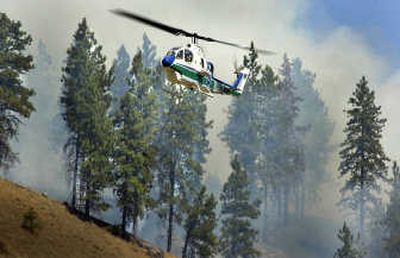‘Initial attack’

A familiar image of a wildfire might be 50-foot flames with water-hauling helicopters circling a tower of black smoke. But for Helitack, the Washington Department of Natural Resources’ helicopter firefighting team, the average assignment is much smaller.
Helitack’s goal is to keep fires under 10 acres. Last year, the team was 96 percent successful, said Dan Boyle, helicopter program coordinator. However, once a fire gets larger than 1,000 acres, it’s essentially beyond Helitack’s control.
“Our main mission for the helicopters is keeping the fires small,” Boyle said. “It’s called ‘initial attack.’ “
To meet that goal, Helitack coordinators make sure their copters are a maximum two hours away from anywhere in Eastern Washington, said Bram Thrift, the program’s crew supervisor. Helicopters’ biggest advantage is the ability to access remote areas – places it would take ground crews hours to reach.
Choppers and supply trucks are based at several DNR sites across Washington. The main hub is in Ellensburg, and this summer the program has had crews stationed in Colville, Omak and Pomeroy. Helitack officials move crews based on firefighting needs and weather forecasts, such as lightning, Thrift said. Support trucks bring supplies and helicopter fuel if the DNR anticipates a long stay at a wildfire.
The firefighters don’t stay in hotels – they sleep at the base or pitch tents wherever they’re dispatched.
“It’s a great perspective,” said Thrift, who’s been with Helitack since 2003. “It’s really fun to fly across country and see different parts of the state.”
But once at a fire, it’s all business. In heavily wooded areas, it can be tough for ground crews to see how a fire is behaving, Thrift said. From the air, Helitack personnel can size up a blaze and give firefighters the upper hand.
Crews in the air and on the ground must constantly coordinate to come up with the best attack plan. “It’s really fun because it requires really quick thinking,” Thrift said.
As soon as they get a call, the crew members suit up and head to the pad. For any fire, crew coordinators have two Bell helicopter choices: Hueys or Cobras. Both types are Vietnam-era military surplus choppers, and each has its strengths in fighting wildfires.
The Cobras, which Helitack acquired in 2004, are narrow ex-gunships that fly fast and high. They hold only two crew members but can carry a 320-gallon bucket of water to an altitude of 7,000 feet, which is handy for wildfires in the Cascades, said Dave Doan, the DNR’s fire aviation manager in Olympia.
“The Cobra’s just strictly a tool for carrying water,” he said.
Hueys can carry just 250 gallons of water and can’t fly as well at high altitudes, but can ferry a crew of six to a wildfire, Doan said.
“If it’s a fire, initial attack where we put crew on the ground, we’ll use a Huey,” Boyle said of the lumbering aircraft Helitack first acquired about 15 years ago.
In all, Helitack flies four Cobras and five Hueys, one of which is leased from Chelan County Fire District 1. The firefighting team has 29 crew members including eight pilots.
If a fire season takes a turn for the worse, Helitack and other regional fire agencies don’t have to go it alone. With the Northwest Compact – an agreement among Washington, Idaho, Oregon, Montana, British Columbia and Alberta – fire crews can help across borders and state lines.
“We’re running crews and engines and aircraft across the border all the time,” said Rex Reed, fire program manager for the DNR’s southeast region. “Fire protection today is a cooperative effort.”
Helitack, however, hasn’t seen any action in the Idaho Panhandle this summer, said Rette Bidstrup, dispatch coordinator for the DNR’s northeast region.
This summer, air tankers from Canada and Idaho have routinely helped in Washington, but not helicopters, and not the other way around. That’s because most of the region’s wildfires have been in central and northeast Washington this summer, said Bud McConnaughey, assistant aviation officer at the Coeur d’Alene Interagency Wildland Fire Center.
The Tunk Grade fire, which burned 15,540 acres near Tonasket in July, was one of the largest blazes Helitack has responded to this summer. But August is notoriously the worst month for wildfires, and this one has been unsettlingly calm.
Through late July and early August, hot weather and lack of rain dried out the land. But the recent rain relief has changed the “short-term character” of the fire season for the better, Thrift said.
“It could change within a week or so,” he said. “We could be back to some pretty significant fire potential.”